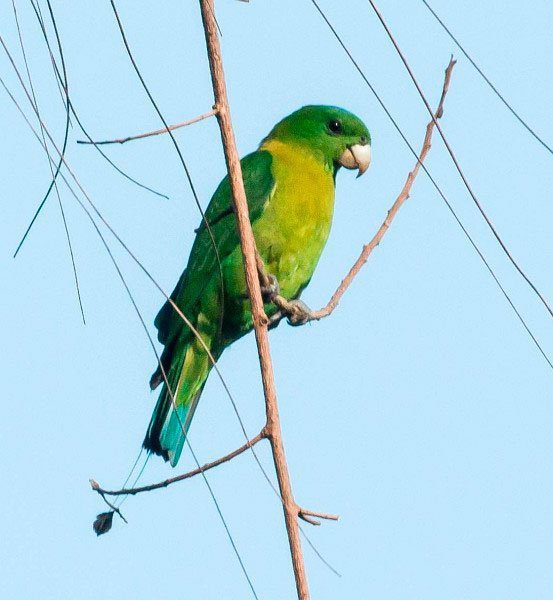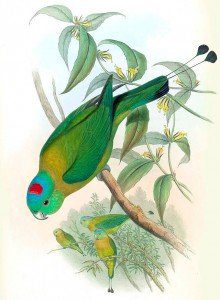Content |
|---|
Description
37 cm.. length.
The head of the Yellowish-breasted Racquet-tail (Prioniturus flavicans) is bright green, brighter around the lores and the base of the bill.
The front of the crown is green, rest of bright blue with red spot in the center crown. Mantle ocher yellow, well delimited from the blue nape the green of the wings and back; Back and rump green. Wings green, with vane Dark internal to the flight feather and blue to primaries longer. green's Underwing coverts; underside of primaries marked dark blue.
Underparts brighter yellowish green, ocher yellow in the chest. Upper, the outer feathers of the tail green with black and turquoise tips on vane outside of the outer feathers; below, the tail dark colored, bathed in blue at the edges of the vane inner; spatulas blackish.
Bill horn; the dark brown irises; the gray legs.
Female less blue, no red dot on the crown, the underparts and the mantle, greener and rackets (a thin extension of the central tail feathers, almost as hair, It is ending with a more oval-shaped racket) shorter.
Young without rackets.
- Sound of the Yellowish-breasted Racquet-tail.
Habitat:
Found in the primary forest usually below the 1,000 m. But times may vary up to the 1.900 m. They are also observed in trees in cultivated areas.
Reproduction:
Little is known of their reproductive habits.
Food:
The birds they feed on the ground, among the plants of lowland and Hill forests, flocking often in fruit trees. They feed slowly along with other frugivorous birds..
Distribution:
Size of its range (breeding/resident ): 66.700 km2
Are distributed in the North of Sulawesi, Indonesian and on the Islands around, including Bangka, Lembeh and Togian. The species also, possibly, It is distributed in groups of Islands Sangir and Banggai. Although its population may be declining due to habitat loss and trade in birds, It is not considered threatened and is still, relatively, common on reserve Dumoga-Bone. It overlaps, although it is less common, with the Golden-mantled Racquet-tail.
Conservation:
• Current category of the Red List of the UICN: Near threatened
• Population trend: Decreasing
The population It has been estimated in the order of 45.000 individuals (Walker and Cahill 2000).
It is suspected that this species has diminished recently at a moderately fast pace, due to the continuing loss of forests.
Conservation Actions Proposed:
-
– Evaluate the threats to this species. Calculate loss of forests in the lowlands of the North of Sulawesi.
– Investigate the level of dependency of the forest habitats of the species.
– Protect effectively important tracts of forest right in key places, both in strict protection areas and in multiple use areas.
"Yellowish-breasted Racquet-tail" in captivity:
Not found in captivity.
Alternative names:
– Yellow-breasted Racquet-tail, Yellow-breasted Racket-tail, Red Spotted Racket-tailed Parrot, Red-spotted Racket-tailed Parrot, Red-spotted Racquet-tail, Red-spotted Racquet-tail Parrot, Red-spotted Racquet-tailed Parrot, Yellowish breasted Racquet tail, Yellowish-breasted Racket-tail, Yellowish-breasted Racket-tailed Pa, Yellowish-breasted Racquet Tail, Yellowish-breasted Racquet-tail, Yellowish-breasted Racquet-tailed P (ingles).
– Palette de Cassin, Perroquet à raquette de Cassin (French).
– Flaggenschwanzpapagei, Flaggen-Schwanzpapagei (German).
– Prioniturus flavicans (Portuguese).
– Lorito momoto Amarillento, Lorito Momoto Amarillo, Lorito-momoto Amarillento (español).
scientific classification:

– Order: Psittaciformes
– Family: Psittaculidae
– Genus: Prioniturus
– Scientific name: Prioniturus flavicans
– Citation: Cassin, 1853
– Protonimo: Prioniturus flavicans
Images “Yellowish-breasted Racquet-tail”:
Videos "Yellowish-breasted Racquet-tail"
————————————————————————————————
“Yellowish-breasted Racquet-tail” (Prioniturus flavicans)
Sources:
– Avibase
– Parrots of the World – Forshaw Joseph M
– Parrots A Guide to the Parrots of the World – Tony Juniper & Mike Parr
– Birdlife
– Photos:
(1) – By © Simon van der Meulen – Oriental Bird Images
(2) – «Prioniturus flavicans" for John Gould – [1]. Available under the Public Domain license via Wikimedia Commons.
– Sounds: Mike Nelson (Xeno-canto)


